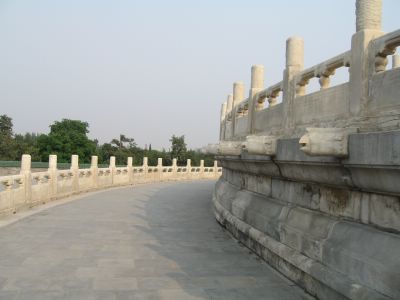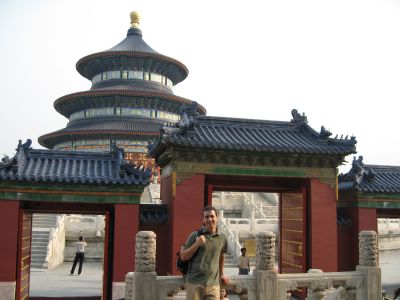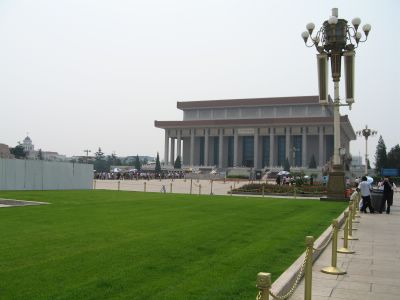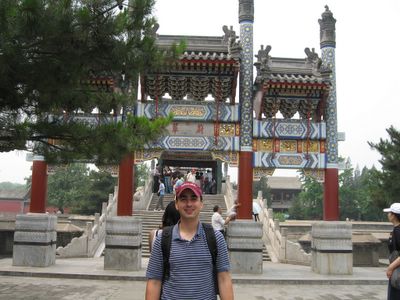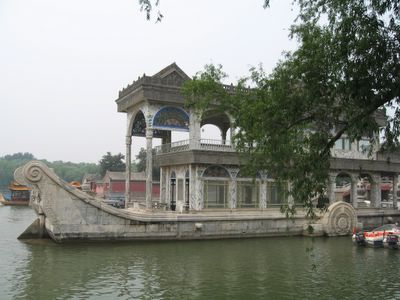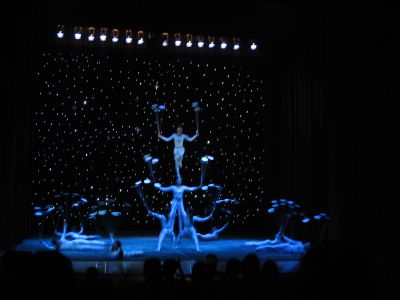We arrived in Bangkok late on Friday night. On Saturday we awoke early and headed to Bangkok's old town, where many of the large temples are located. The first stop was Wat Phra Chetuphon Vimolmangklararm Rajwaramahaviharn, or more simply, Wat Po. Wat Po is the original home of Thai massage and the largest Buddha image in Thailand - the Reclining Buddha.

Wat Po
Over 46 meters long, the reclining Buddha is an impressive sight. It is meant to depict the Buddha's passing into nirvana.

Reclining Buddha

Reclining Buddha
The feet of the Buddha are decorated with mother of pearl inlays. It may be considered disrespectful to point your feet at the Buddha, but apparently not the other way around.

Buddha feet
The temples required appropriate dress (no shorts or sleveless shirts) and required visitors to remove their shoes.

Take off your shoes
The compound is home to many monks, but we only saw a few out and about the morning we visited. It could be that they were still asleep after watching world cup games the previous night.

Annette smiles while a monk walks by
The wat is full of interesting statues of various sizes. Many of them look like cross-bred animals, like a warthog-dragon (does that make a wagon?) Others are images of strange looking people.

Small statue

This statue is bored
There were several of these huge statues of figures with canes, top hats, and overcoats. I thought they looked Peruvian, while Annette insisted they are leprechauns (mostly becaues of the shoes). No no no, Annette - leprechauns are waaay smaller!

Peruvian or Leprechaun? You decide.

Wat Po
Wat Po is full of elaborately decorated spires, called "chedis." Some of them are covered with broken porcelain pieces that Chinese ships carried to Thailand as ballast.

Wat Po

Wat Po courtyard

Roof

Roofing tiles in a pile

Wat Po

Wat Po
Bordering the courtyards, there are glass cases full of golden Buddha statues. They pose in many different ways. Some hold up one hand, some hold up both, some neither. Also, some are draped in orange cloths while other are not. Are some Buddhas more modest than others?

Stop in the name of love... (or maybe Hey Buddha-rena...)

Hot at Wat Po

Wat Po

This must have taken some monk a long time to complete. It keeps them from getting bored.
The next stop was the Grand Palace, where Thailand's kings resided from the 18th to 20th century. The compound also houses many important Buddhist landmarks, including the highly revered Emerald Buddha.

Grand Palace
This golden Chedi contains the relics of Lord Buddha, although I have no idea what the 'relics' might consist of. Nevertheless, it is an interesting piece of architecture. [Note for those who have not traveled to the religious sights of the world and seen relics - this is usually a fancy name for body parts. Bones, teeth, hair...whatever they can find. At least here (unlike Europe) they were not displayed under glass.]

Phra Sri Ratana Chedi

Phra Sri Ratana Chedi

Grand Palace
Circling the grand palace are murals depicting scenes from the Ramakien epic. In the story there are a bunch of gods, then someone leads an army of monkeys in defeating an army of demons. Yeah, I don't get it either, but evidently the story is a favorite of the Thai people.

Restoring some of the murals
Around the palace, giants guard the emerald Buddha.

Giant

Grand Palace

Flower

Flower
This chedi is surrounded by neat looking creatures from the Ramakien epic. Some are monkeys, some demons, though it was kind of hard to differentiate. There are also some hybrid animals from the story, including lion-angels which look like birds with tails.

Golden Chedi

Creature

Creature

Grand Palace

Model of Angkor Wat

Grand Palace

Giants guard the entrances
After touring the compound for a while, we finally came to the centerpiece - Wat Phra Kaew. This is where the emerald Buddha resides. The emerald Buddha is very popular with the locals, and many of the faithful were giving offerings of lotus flowers and incense outside the temple.

Wat Phra Kaew

Wat Phra Kaew
We took off our shoes and went inside, where several hundred people were seated on the floor. Many were tourists, but others were bowing and meditating in the presence of the Buddha. The Buddha has three golden outfits for each of the three seasons (hot, rainy, and cold.) On the appropriate day, the king himself comes to change the Buddha's clothes.
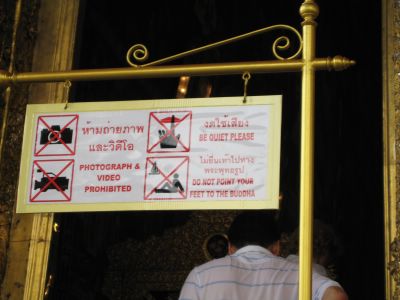
Rules for Wat Phra Kaew
As you can see, we weren't allowed to take pictures inside, but in this photo you can (barely) see the Buddha through the front door.

The Buddha

Statue of the Buddha's doctor.
Next we passed by the former residence of the King. This building was an interesting mixture of French and Thai architecture.
As a side note: If there is one thing we learned, Thais love their king. The weekend before we visited, the King celebrated his 60th year on the throne. To mark the occasion, people sold yellow shirts and wristbands (yellow is the Kings' birth color). We were amazed by the number of people wearing yellow, even a week after the celebration. [Fun game - go back through any picture with a crowd and count the number of yellow shirts]

Grand Palace
There are many Chinese statues around the grand palace. These were also brought to Thailand as ballast for Chinese ships.

Former ballast

Chakri Maha Prasat Hall

Annette strikes up a conversation

The king used this pavilion to disrobe after parades

Grand Palace

Enough heat already! Time to cool off.
Well, this is where the pictures end, but it was not the end of our adventure. Shortly after leaving the Grand Palace, we caught a taxi back to the hotel to do a little shopping in the nearby mall. Right after we caught the taxi, a strong thunderstorm came over us and it took us nearly an hour to get a few miles back to the hotel. Amazingly, the taxi fare was only around US$3.
The mall near our hotel was huge! There were all kinds of stores selling real and fake goods side by side. The $5 Birkenstocks were too good to pass up. Evidently other tourists thought so too; we saw them being worn everywhere.
We ate dinner at one of the many restaurants at the mall, and later went to Patpong street to check out the night market, which had the usual collection of t-shirts, mass-manufactured crafts, fake watches, knock-off handbags, CDs and DVDs.
Back at the hotel that night, Bangkok got the best of Wes yet again, despite his best efforts to stick to bottled water and not eat anything too weird. As a result, the next morning we were slightly delayed in making our trip to the Chatuchak weekend market. This market is a huge maze of stalls where vendors peddle clothing, crafts, home furnishings, food, and even pets. Wes had to spend most of the time sitting down while Annette shopped - which meant it was exactly like the last trip to the weekend market.
After the market, it was time for a little more shopping at the mall before heading to the airport. All in all, it was a good trip to Bangkok and we hope to see more next time we're passing through on the way to the beach. That is, if Wes is brave enough to set foot in Bangkok again.






